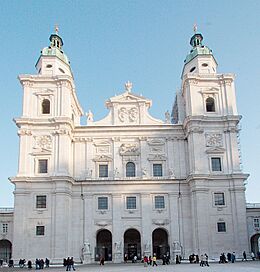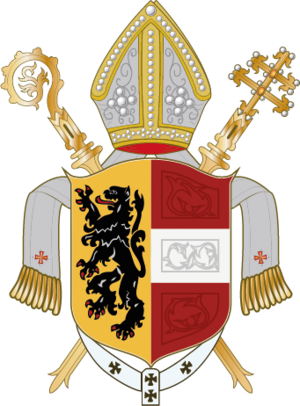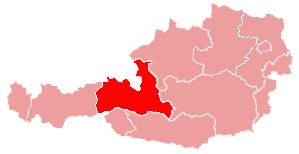Roman Catholic Archdiocese of Salzburg facts for kids
Quick facts for kids Archdiocese of SalzburgArchidioecesis Salisburgensis Erzdiözese Salzburg |
|
|---|---|

Salzburger Dom
|
|

Coat of arms
|
|
| Location | |
| Country | Austria |
| Territory | Salzburg, Tyrol |
| Ecclesiastical province | Archdiocese of Salzburg |
| Metropolitan | Salzburg, Salzburg |
| Statistics | |
| Area | 9,715 km2 (3,751 sq mi) |
| Population - Total - Catholics |
(as of 2020) |
| Parishes | 210 |
| Information | |
| Denomination | Roman Catholic |
| Rite | Roman Rite |
| Established | 20 April 798 |
| Cathedral | Cathedral of Saint Rupert and Saint Vergilius |
| Patron saint | Saint Rupert Saint Virgil |
| Secular priests | 196 (diocesan) 97 (religious orders) 54 permanent deacons |
| Current leadership | |
| Pope | Francis |
| Metropolitan Archbishop | Franz Lackner, O.F.M. |
| Auxiliary Bishops | Hansjörg Hofer |
| Vicar General | Roland Rasser |
| Episcopal Vicars | Gottfried Laireiter |
| Map | |
 |
|
| Website | |
| kirchen.net/portal | |
The Archdiocese of Salzburg is an important part of the Catholic Church in Austria. It is located in the city of Salzburg. It is one of two main archdioceses in Austria, the other being the Archdiocese of Vienna.
For a long time, the Archbishops of Salzburg were not just church leaders. They were also powerful rulers called prince-archbishops. They governed their own land, the Prince-Archbishopric of Salzburg, within the Holy Roman Empire. This special role ended in 1803. After that, the archbishops only had religious power, not political power.
History of the Archdiocese
The first signs of Christianity in the Salzburg area date back to 477 AD. A priest named Maximus and his followers lived near a place called Juvavia. Sadly, they were killed by invaders. An old book, "Life of Saint Severinus," mentions Maximus as a priest.
How the Diocese Started
In 739, a famous missionary named Boniface divided Bavaria into four church areas, called dioceses. One of these was in Salzburg. Boniface chose Abbot Joannes from S. Peter's monastery in Salzburg to be its first bishop.
The bishops continued to live in S. Peter's monastery until the 12th century. In 774, Bishop Vigilius dedicated a new church. This church was named after Bishop Hrodpertus and became the cathedral. The monks of S. Peter's helped with services there.
Later, in 1122, Archbishop Conrad created a separate group of priests, called canons, for the cathedral. This was approved by Pope Calixtus II in 1123 and Pope Honorius II in 1125.
On April 20, 798, Pope Leo III made Salzburg a metropolitan archdiocese. This meant it became a very important church area with other dioceses under its leadership. These included Passau, Ratisbon, Freising, Säben-Brixen, and Neuburg.
In 1070, Archbishop Gebhard created a new diocese called Gurk. This was made from part of Carinthia. The boundaries for Gurk were set in 1131.
In 1163, Pope Alexander III appointed Archbishop Eberhard of Salzburg as his special representative for the German kingdom.
Archbishop Adalbert and Emperor Frederick Barbarossa
Archbishop Adalbert became archbishop in 1168. He was the son of the King of Bohemia. In a disagreement within the church, Adalbert supported Pope Alexander III. This was against the Holy Roman Emperor Frederick Barbarossa.
Emperor Frederick Barbarossa did not like Adalbert's choice. In 1169, the Emperor refused to meet Adalbert and even invaded Salzburg's territory. The Pope asked the King of Bohemia and the Duke of Austria to help Adalbert.
In 1172, the Emperor held a meeting in Salzburg, but Adalbert was not invited. The Emperor tried to get the church leaders to choose a different archbishop. In 1173, Barbarossa attacked Austria and Bohemia.
In 1174, Frederick Barbarossa held another big meeting. He tried to remove Adalbert from his position. The assembly chose a new archbishop, Heinrich. However, Pope Alexander III said that all these actions against Adalbert were invalid.
To make peace with the Emperor, Pope Alexander III removed Adalbert from his position in 1177. Cardinal Conrad of Mainz was then appointed archbishop of Salzburg. However, Adalbert was later given his position back in 1183. Pope Lucius III confirmed his rights in 1184.
Popes and the See of Salzburg
In 1246, Pope Innocent IV made a rule that church leaders in Germany needed his permission to choose new bishops. This was because some German bishops supported Emperor Frederick II. When Archbishop Eberhard of Salzburg, a supporter of Frederick, died in 1246, Pope Innocent wanted to act quickly.
The church leaders in Salzburg chose Philippus as their new archbishop. But Pope Innocent ignored their choice. He appointed Burcardus as archbishop and consecrated him himself. Sadly, Burcardus died on his way to Salzburg in 1247.
Pope Innocent then appointed Philippus as a temporary leader. Philippus held a church meeting in 1249. However, Philippus caused problems with his behavior. In 1256, the new pope, Pope Alexander IV, allowed the Church of Salzburg to choose a new archbishop.
They chose Ulrich, the Bishop of Seckau. This choice was challenged by some powerful dukes and kings. Finally, in 1257, Pope Alexander confirmed that Philippus was removed and Ulrich was the new archbishop of Salzburg.
Church Meetings (Synods)
Archbishop Arno held church meetings in 799 and 807. Archbishop Eberhard held one in 1219. In 1569, Archbishop Johann Jakob von Kuen-Belasy led a provincial synod. These meetings were important for discussing church rules and matters.
Suffragan Dioceses
The Archdiocese of Salzburg is the main diocese for several others. These are called suffragan dioceses:
- Feldkirch
- Graz–Seckau
- Gurk
- Innsbruck
Archbishops of Salzburg
Here is a list of the bishops and archbishops who have led the Archdiocese of Salzburg over the centuries.
Bishops of Iuvavum (later Salzburg)
- Hrodbertus (Ruprecht) c. 698 – c. 718
- Vitalis
- Erkenfried
- Ottokar
- Flobrigis
- Johann I
- Virgil of Salzburg, c. 745 or c. 767 – c. 784
Archbishops of Salzburg, 798–1213
- Arno 785–821
- Adalram 821–836
- Liupram 836–859
- Adalwin 859–873
- Adalbert I 873
- Dietmar (I) 873–907
- Pilgrim 907–923
- Adalbert (II) 923–935
- Egilholf 935–939
- Herhold 939–958
- Friedrich (I) 958–991
- Hartwig 991–1023
- Günther 1024–1025
- Dietmar (II) 1025–1041
- Baldwin 1041–1060
- Gebhard 1060–1088
-
- Berthold of Moosburg (1085–1106) Intrusus
- Thiemo 1090–1101
- Konrad von Abensberg 1106–1147
- Eberhard von Hilpolstein-Biburg 1147–1164
- Konrad (II) of Austria 1164–1168
- Adalbert III of Bohemia 1168–1177
-
- Heinrich (1174–1177) Intrusus
- Conrad von Wittelsbach 1177–1183
- Adalbert III of Bohemia (restored) 1183–1200.
Prince-Archbishops of Salzburg, 1213–1803
From 1213 to 1400
- Eberhard of Regensburg 1200–1246
- Bruccardus of Ziegenhain 1247
- Philipp of Carinthia 1247–1256
- Ulrich of Sekau 1256–1265
- Ladislaus of Salzburg 1265–1270
- Frederick II of Walchen 1270–1284
- Rudolf of Hoheneck 1284–1290
- Conrad von Vonstorff (Breitenfurt) 1291–1312
- Weichard of Pollheim 1312–1315
- Frederick (III) von Leibnitz 1315–1338
- Henry of Pirnbrunn 1338–1343
- Ordulf of Wiesseneck 1343–1365
- Pilgrim von Puchheim 1365–1396
- Gregor Schenk von Osterwitz (6 Jun 1396 Appointed – 9 May 1403)
From 1400 to 1803
- Berthold von Wehingen (1404 – Jan 1406 Resigned)
- Eberhard von Neuhaus (1406 – 1427)
- Eberard von Starhemberg (11 Apr 1427 Confirmed – 9 Feb 1429)
- Johann von Reisberg (1429 Elected – 1441)
- Friedrich Truchseß von Emmerberg (30 Sep 1441 Elected – 3 Apr 1452)
- Sigmund von Volkersdorf (10 Apr 1452 Elected – 3 Nov 1461)
- Burkhard von Weißpriach (16 Nov 1461 Elected – 16 Feb 1466)
- Bernhard von Rohr (25 Feb 1466 Elected – 21 Mar 1487)
- Johann Beckenschlager (21 Mar 1487 Succeeded – 15 Dec 1489)
- Friedrich Graf von Schaumberg (19 Dec 1489 Elected – 4 Oct 1494)
- Sigmund von Hollenegg (16 Oct 1494 Elected – 1495)
- Leonhard von Keutschach, C.R.S.A. (7 Jul 1495 Elected – 8 Jun 1519)
- Matthäus Lang von Wellenburg (8 Jun 1519 Succeeded – 30 Mar 1540)
- Michael von Kuenburg (21 Jul 1554 Elected – 17 Nov 1560)
- Johann Jakob von Kuen-Belasy (28 Nov 1560 Elected – 4 May 1586)
- Georg von Kuenburg (4 May 1586 Succeeded – 25 Jan 1587)
- Wolf Dietrich von Raitenau (2 Mar 1587 Elected – 7 Mar 1612 Resigned)
- Markus Sittikus von Hohenems (1612 – 1619)
- Paris von Lodron (13 Nov 1618 Elected – 15 Dec 1653 Died)
- Guidobald of Thun (3 Feb 1654 Elected – 1 Jun 1668)
- Maximilian Gandolf Reichsgraf von Kuenburg (30 Jul 1668 Elected – 3 May 1687)
- Johann Ernst Reichsgraf von Thun (30 Jun 1687 Elected – 20 Apr 1709)
- Franz Anton Fürst von Harrach zu Rorau (20 Apr 1709 Succeeded – 18 Jul 1727)
- Leopold Anton Eleutherius Reichsfreiherr von Firmian (4 Oct 1727 Elected – 22 Oct 1744)
- Jakob Ernst Graf von Liechtenstein-Kastelkorn (1745 – 1747)
- Andreas Jakob Reichsgraf von Dietrichstein (10 Sep 1747 Elected – 5 Jan 1753)
- Sigismund Christoph von Schrattenbach (5 Apr 1753 Elected – 16 Dec 1771)
- Hieronymus Colloredo von Wallsee und Mels (1772 – 1812)
-
- Sede vacante (1812–1823)
Archbishops (from 1823)
- Augustin Johann Joseph Gruber (17 November 1823 Confirmed – 28 June 1835)
- Friedrich Johann Joseph Cölestin zu von Schwarzenberg (1 February 1836 Confirmed – 20 May 1850 Confirmed)
- Maximilian Joseph von Tarnóczy (17 Feb 1851 Confirmed – 4 April 1876 Died)
- Franz de Paula Albert Eder, O.S.B. (29 Sep 1876 Confirmed – 10 April 1890 Died)
- Johannes Evangelist Haller (26 June 1890 Confirmed – 5 May 1900 Died)
- Johannes Baptist Katschthaler (17 December 1900 Confirmed – 27 February 1914 Died)
- Balthasar Kaltner (25 May 1914 Confirmed – 8 July 1918 Died)
- Ignaz Rieder (7 October 1918 Confirmed – 8 October 1934 Died)
- Sigismund Waitz (17 December 1934 Confirmed – 30 October 1941 Died)
- Andreas Rohracher (1 May 1943 Confirmed – 30 June 1969 Retired)
- Eduard Macheiner (18 October 1969 Confirmed – 17 July 1972 Died)
- Karl Berg (9 January 1973 Confirmed – 5 September 1988 Retired)
- Georg Eder (17 January 1989 Confirmed – 23 November 2002 Resigned)
- Alois Kothgasser, S.D.B. (27 November 2002 Appointed – 4 November 2013 Retired)
- Franz Lackner, O.F.M. (18 November 2013 Appointed – present)
Images for kids




